UCV Civil War Military Operations Marker #12: Smithfield (Middleway) 1862-1864
Introduction
Text-to-speech Audio
Images
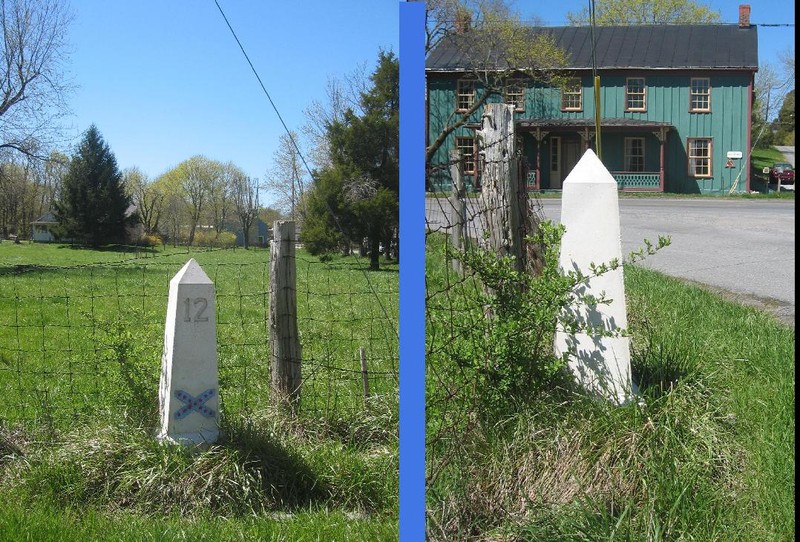
Lieut. George Baylor, 12th VA Cavalry
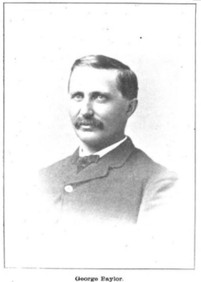
Lieut. Milton Rouss, 12th VA Cavalry
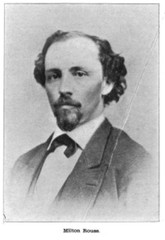
Report of J. W. Garrett, President of the B & O Railroad, August 24, 1862
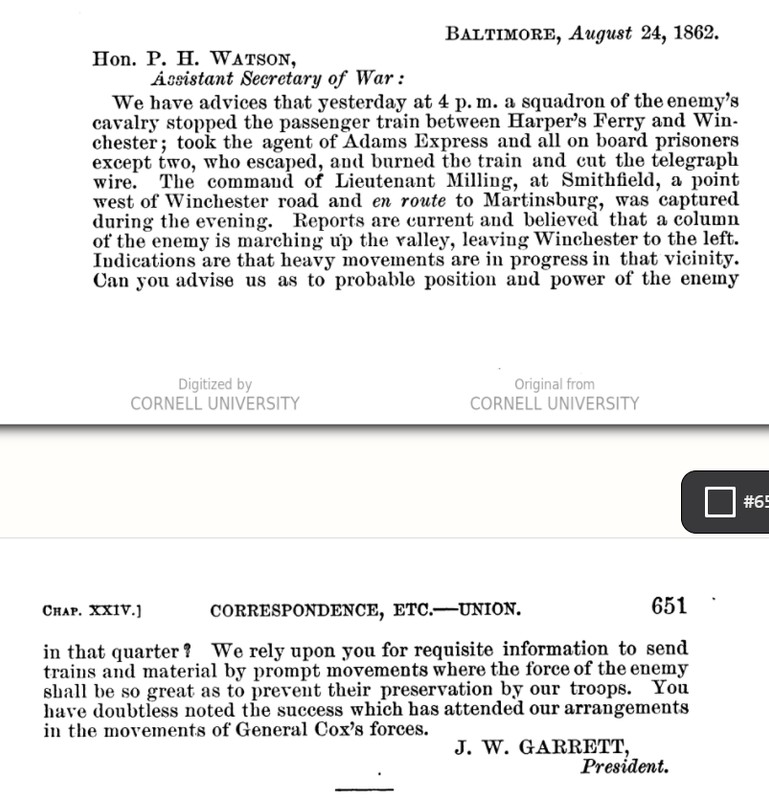
Reports of Brig. Gen. Julius White, commanding at Winchester (1862)
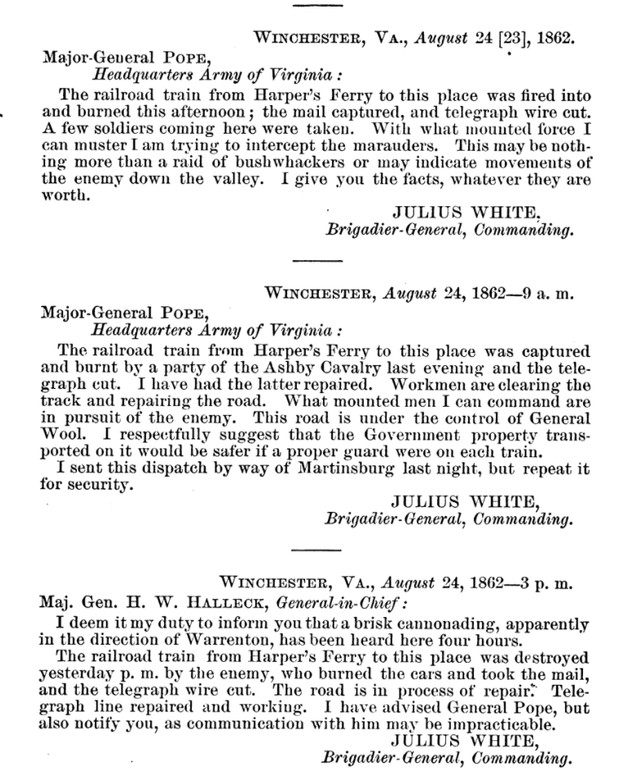
Report of Lieutenant Robert H. Milling, commanding the pickets at Smithfield on August 23, 1862
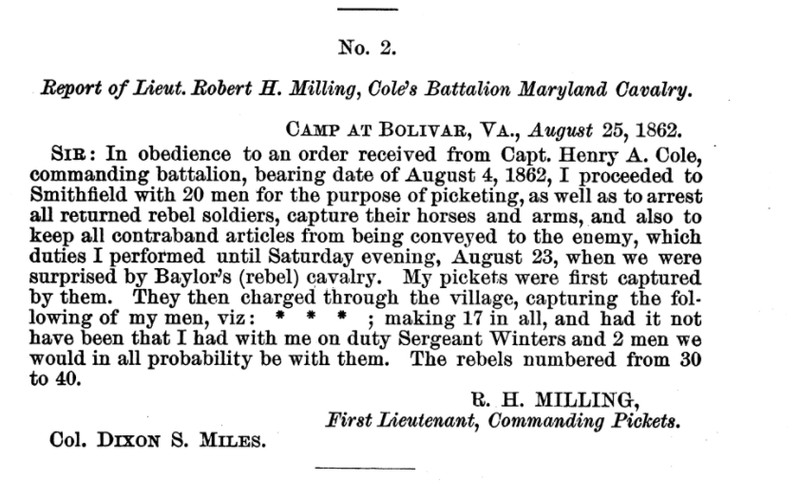
Lieutenant Milling did not fare well after the failure of his pickets at Smithfield (1862)
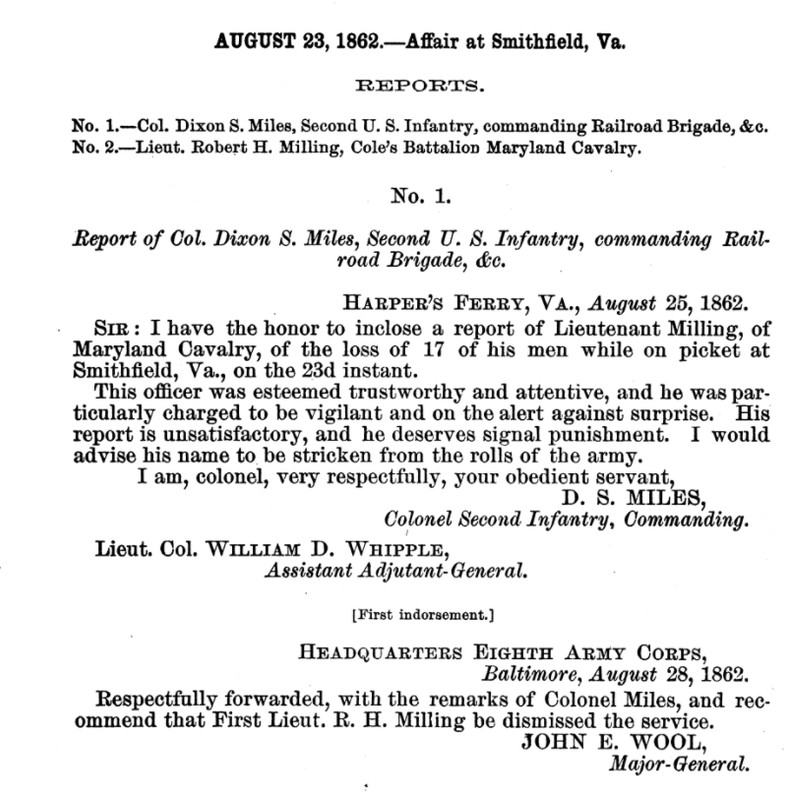
Lieutenant Milling did not fare well after the failure of his pickets at Smithfield (1862)

William Manning, 12th VA Cavalry
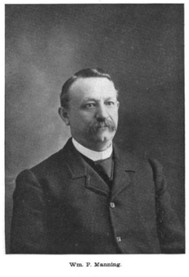
C. Henderson, 12th VA Cavalry
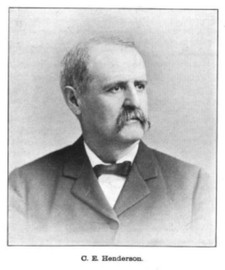
John Yates, 12th VA Cavalry
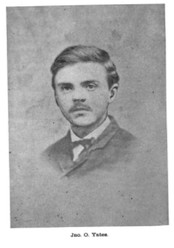
John Coleman, 12th VA Cavalry
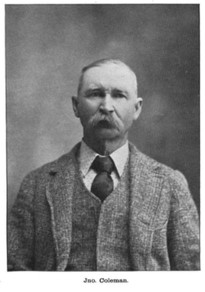
George Creaton, 12th VA Cavalry
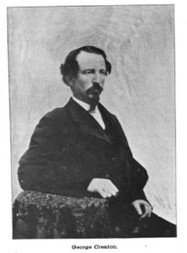
Joseph Crane, 12th VA Cavalry

Warren D. English, 12th VA Cavalry

Union report for the skirmish of February 12, 1863.

Jedediah Hotchkiss' map of the August 29, 1864 engagement. Serving with the Confederate Army the entire war, Hotchkiss is the most famous cartographer of the Civil War.
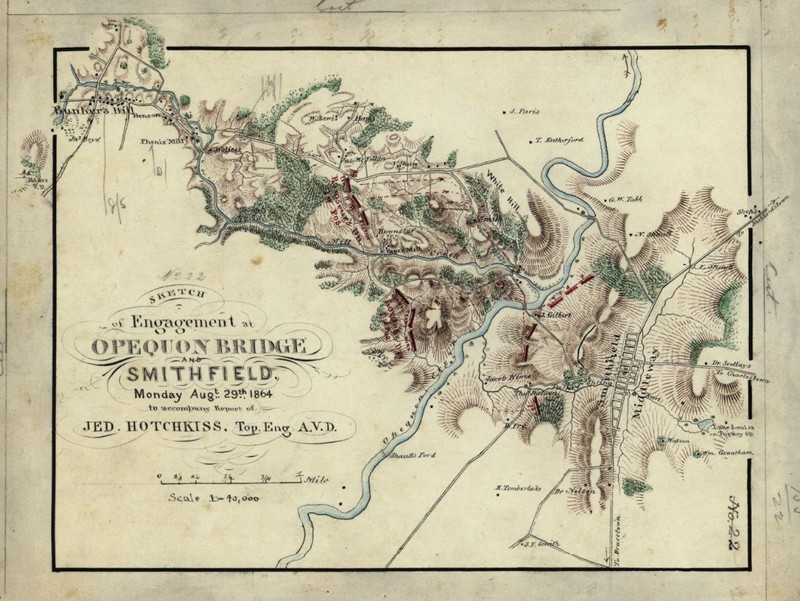
Jedediah Hotchkiss' map of the August 29, 1864 engagement, part b.

Map of Smithfield Crossing Battlefield core and study areas by the American Battlefield Protection Program

Backstory and Context
Text-to-speech Audio
Raid on the Winchester & Potomac Railroad & Smithfield (Middleway): August 23, 1862
On August 22, 1862, thirty soldiers from Turner Ashby’s cavalry led by Lieutenants Milton Rouss and George Baylor left camp at Mount Jackson, VA and road through the night. They eluded the Federal garrison at Winchester and arrived in Jefferson County near Summit Point. The men needed supplies, so they decided to rob the Winchester & Potomac Railroad train on route from Harpers Ferry to Winchester. Union soldiers guarded both Smithfield Depot and Wade’s Depot, about 4 miles apart, and Baylor positioned his men between the two depots in the afternoon of August 23. The train was due to pass through around 4:00pm and Baylor’s men placed obstructions on the tracks to stop the oncoming train, which was successful. When the train stopped Baylor’s men raided the train, taking eight Union prisoners and the supplies on the train. This included $4,000 and the U.S. mail, which included correspondence between Major General John Pope to Brigadier General Julius White in command of Winchester. Once the raid was complete, Baylor’s men set the train on fire, sent it towards Winchester, and cut the telegraph wires to prevent Union forces sending messages once the train was discovered. The burned train ended up stopping about three miles outside of Winchester. Lieutenant George Rowland took charge of the prisoners from the train, while Baylor and Rouss continued towards Smithfield.
As Baylor and Rouss approached Smithfield, the Union pickets mistook them for Union soldiers, allowing for the Confederate riders to quickly surprise and capture the three Federals. Based on information learned from the captured pickets, Baylor and Rouss were able to ride into town and capture the remaining force of 14 Union soldiers, plus supplies.
Skirmish of February 12, 1863:
During the winter of 1863 there was reconnaissance and skirmishing as both armies tried to maintain or secure control over the Lower Shenandoah Valley. On February 12, 1863 Confederate cavalry from the 12th Virginia under Lieutenants Rouss and Baylor left Harrisonburg, VA. They crossed the Massanutten Mountains near Front Royal, VA and then proceeded north into Jefferson County. The Confederate riders received intelligence that a party of 21 Union cavalrymen from the 12th Pennsylvania Cavalry were headed towards Middleway. Deciding to pursue, Baylor’s men ambushed the 12th PA scouts around 1:00 in the afternoon, surprising them and forcing the Federals to retreat towards Charles Town. In this first skirmish, the Confederates reported no casualties, but 4 killed, 3 wounded, and 7 men (plus 11 horses) captured on the Union side.
Baylor and Rouss’ men returned towards Summit Point and had to stop at Locke’s shop to have Rouss’ horse shod. As the Blacksmith was finishing up the work around 4:00 in the afternoon, the Confederate party saw a column of Union soldiers advancing towards their location. A few of the men, led by John Chew and Charles Crane, charged the Union column to distract them, which was successful in allowing most of the Confederates to get away. George Baylor, John Coleman, and Upshur Manning were captured by the Union soldiers when they were thrown from their horses during the retreat. There was a running battle for a few miles, during which the Union were able to rescue their captured comrades and horses.
Battle of Smithfield Crossing, August 28-29, 1864:
This engagement is connected to the engagements between Generals Jubal Early and Philip Sheridan in August 1864 (markers #10, 11, and 20).
On August 21, 1864 the Confederate force under General Jubal Early and Union force under General Philip Sheridan fought the Battle of Summit Point, followed by skirmishes on August 25-26 at Shepherdstown, Charles Town, and Kearneysville. Returning to Bunker Hill on August 26, Early left cavalry under Fitz Hugh Lee and Lunsford L. Lomax at Shepherdstown and Anderson still guarded Charles Town. On August 26 Sheridan’s force at Halltown took advantage of Anderson’s diminished numbers and attacked with two infantry divisions (Major General George Crook) and a cavalry brigade (Brigadier General Russell Lowell). This attack forced Anderson from his earthworks outside of Charles Town into the town proper. Ultimately, Crook forced Anderson out of Charles Town towards Early at Bunker Hill; Anderson stopped at Stephenson’s Depot near Middleway. Sheridan needed to regain control of the entire area so on August 28 he ordered Merritt’s cavalry to remove the Confederate cavalry from Shepherdstown. Merritt’s men successfully forced the cavalry under Lee and Lomax to retreat towards Middleway. At Leetown, Lomax ordered Harry Gilmor to defend the road, but the Union quickly forced his men to retreat and the Federals were able to retake control of Middleway. One August 29, Early attempted to retake Middleway by sending Major Generals Ramseur and Gordan towards the Opequon Creek. Initially the Confederate force was able to dislodge the Union from Middleway; however, Sheridan needed to prevent Early from advancing again on Charles Town and in the afternoon the Union force was able to retake Middleway and force Early from the county.
About the Monuments:
This series of monuments and accompanying tour pamphlet were part of an initiative from the Jefferson County Camp, United Confederate Veterans to commemorate the 50th anniversary of the Civil War. In 1910 Col. R. Preston Chew and the Jefferson County UCV raised the funds to place 25 concrete obelisks in Jefferson County to mark locations of engagement or other significant events. The following year the Camp published a pamphlet to accompany the obelisks and give more information about each location. This was Military Operations in Jefferson County, Virginia (Now West Virginia), 1861-1865 published in 1911. The pamphlet has been reprinted several times by the Henry Kyd Douglas Camp, No. 199 of the Sons of Confederate Veterans. Because the monuments and accompanying pamphlet were done by Confederate veterans it is likely that the locations and descriptions are biased towards or favor the Confederate view and experience of the war.
Original Text from the 1911 Pamphlet:
"Marker Number Twelve
Successful Exploits of Confederate Forces About Smithfield
In August 1862 Lieutenant Rouss with Lieut. Baylor, Lieutenant Rowland and thirty men marched down the valley intending to attack the train between Summit Point and Wade’s Depot. In each of these places the enemy had stationed eighty infantry and five cavalry. The distance between the depots was four miles. At four o’clock in the afternoon the road was reached, and soon after the whistle of the engine was heard. Obstructions were placed across the track to bring the train to a stand-still. This proved effectual and when the engine struck the obstruction, the train was halted. It was then boarded by our men and eight yankee solders were captured. The express car was opened, where they found baskets of champagne and boxes of fruit. It is needless to say, as the men were thirsty and hungry, they proceeded to partake of these good things.
The express safe was opened and $4,000 in U. S. money was taken out. Nothing remained to be done but to burn the car. This was done effectually and a full head of steam was put on the engine and it was started in the direction of Winchester. The telegraph wire was cut for two hundred yards.
Lietenant (sic) Rowland with thirteen men took charge of the prisoners and started back over the route they came, while Lieutenants Rouss and Baylor, with the seventeen men remaining, determined to penetrate farther into Jefferson County.
Lieutenant Rouss with these men moved in the direction of Smithfield, five miles distant. When they arrived within half a mile of the town the blue uniforms of the Yankee pickets were discovered.
Thinking we were a scouting party of their own men, Rouss and his party approached within twenty yards of them before they discovered who they were. The command was given to charge, and before they could fire a shot, our men were upon them and captured all three with their arms and equipment.
These pickets informed our men that there were fourteen of their companions in town. A charge was made and the fourteen yankees were captured. Being taken completely by surprise. The spoils amounted to 17 horses, 20 revolvers, 5 Sharpe’s carbines, saddles, bridles and other trappings.
After the capture Lieut. Rouss led his men safely back into our lines.
February, 1863, Lieut. Rouss with Lieut. Baylor, John Chew, Billie Manning, Charlie Henderson, John Yates, John Coleman, George Crayton, Billie Gibson, Up Manning, Joe Crane and Duck English, marched to Summit Point where information was received that a small scouting party of about 21 men had passed that place in the direction of Smithfield.
Rouss immediately started in pursuit of this party. Just before entering the town of Smithfield there is a long straight stretch of road, probably a mile long. There out party came in full view of the foe.
The Confederates approached the enemy, who were entirely unmindful of our presence, and dashed into their rear and shot down some of their party before they were aware of any danger. No resistance was made, but pell-mell down through the town they ran, with Confederates behind them, yelling like hyenas.
Summing up the result of the fight, four were found killed, three wounded, 7 men and 11 horses captured, without a casualty on our side.
A negro man by the name of Redmond, a resident of Jefferson county, who had guided the yankees to people’s homes was shot by Lieut. Rouss and died in a stable north of the town.
The party with their prisoners and horses, returned to Summit Point and from there to Locke’s shop, where a stop was made to have a horse shod. The smith had hardly completed the job when the yankees were seen approaching from Charles Town, and a handful of our men were sent to make a dash on the head of the column. This charge was led by John Chew and Charles Crane and was so successful that the head of the column was broken and thrown into confusion. The balance of the party retreated down Locke’s lane.
The enemy pursued rapidly and captured Frank Manning, John Coleman, and Lieut. Baylor. The rest of the party made their escape.
SMITHFIELD
On the 28th of August, 186--, Early’s cavalry that had been located near Charles Town, was driven back through Middleway and compelled to cross the Opequon, Fitz Lee retreating towards Brucetown and Lomax towards Bunker Hill.
The enemy occupied Middleway, where they burned several barns and houses. To put a stop to this fiendish work Ramsey crossed the Opequon and drove back the Federal cavalry. General Early also crossed the Opequon with infantry and artillery and drove the federals from some rude works they had constructed in front of the town.
He then returned to camp over the Opequon leaving the cavalry behind. The enemy attacked this later in the afternoon and drove them back across the stream. There was considerable loss in these actions.
In February, 1864. General Rosser, with all his command except a small portion which were picketing the outposts down the valley, was west of the mountains on his celebrated cattle raid.
Captain Kearney, with a part of his company engaged in picket duty at the time, and being relieved too late to join Rosser, asked permission to make a scout to Jefferson. The request was granted. He got together nineteen of his company and started, early on the 4th of February, 1864, from New Market; and by 2 a. m. of the fifth, eighteen of his men were hidden in the pines and cedars along the pike, a short distance north of Smithfield.
A picket was placed on the Charles Town pike, and one on the Shepherdstown pike, with instructions to report in haste, the approach of the enemy, and count the number, if possible. It was known that every day a squad came from Shepherdstown or Kearneysville on that pike to Smithfield, and a battalion came from Charles Town three times each week. About sunrise, both pickets came at a gallop, and reported that 22 federals were advancing from Kearneysville. Kearney kept nine of his men to charge down Main street, and sent nine in charge of a sergeant, down a back street, to meet in the centre of the town; and he started these nine a moment ahead to allow for distance. Just at this stage, with the nine gone on their mission, some one exclaimed, “Look there on the Charles Town pike, there comes the battalion,” which unfortunately, was true. Kearney, equal to the emergency, said, “boys, we will charge through the yanks in the town, but don’t stop.” Forward and away we went. We were on them so suddenly, and the surprise was so great, that nearly all surrendered without a shot, not knowing that several hundred of their own men were at hand. We had not time to disarm them. A few took our direction ahead of us; and as soon as we passed those in the street, they, seeing the situation, with the whole battalion, gave chase, and began firing with their carbines, killing one of our best men, David Hoffman. The squad that tried to escape ahead of us on Main street had one killed and several wounded. Two of our squad, wanting a remount, stopped long enough to disarm and dismount two yanks, and, taking as they thought, a near cut to overtake the company, were captured. The horses would not jump fences.
We were thirty-five miles outside our lines. A ruse saved the rest of the company. The major inquired, “how many men had you in that command?” the reb thought quickly, “the truth will be the best answer,” and replied, “Eighteen”, “you are lying”, he said, “Eighteen men would not come so far out of their lines”; and he would not follow.
Our horses were nearly worn out from hard service and the long ride from New Market the day and night before, they could have easily overtaken, at least, some of the men.
Our scout was a failure, as was Captain Baylor’s the year previous.
February 12th, 1863 21 men of the Twelfth Pennsylvania cavalry were scouting in that section, and so was Baylor with 13 of his company. Baylor completely surprised and routed them, killing four, wounding three, and capturing seven men and eleven horses. But on their return south of Charles Town, they encountered a large body of federal cavalry, and lost all they had captured, and Baylor and two of his men were made prisoners.
In August, 1862, Lieutenant Rouss and Baylor; with seventeen men, captured seventeen yankees with their horses and equipments complete, in the Main street of Smithfield, not losing a man."
Sources
Bushong, Millard Kessler. A History of Jefferson County, West Virginia. Charles Town, WV: Jefferson Publishing Company, 1941.
Engle, Stephen Douglas. Thunder in the Hills: Military Operations in Jefferson County, West Virginia, During the American Civil War. Charleston, WV: Mountain State Press, 1989.
Hearn, Chester G. Six Years of Hell: Harpers Ferry During the Civil War. Baton Rouge: Louisiana State University Press, 1996.
Military Operations in Jefferson County Virginia (and West Va.) 1861-1865. Published by Authority of Jefferson County Camp U.C.V. Farmers Advocate Print, 1911. Accessed January 20, 2021. https://babel.hathitrust.org/cgi/pt?id=uc2.ark:/13960/t4vh5gp6c&view=1up&seq=5.
Snell, Mark A. West Virginia and the Civil War: Mountaineers Are Always Free. Charleston, SC: The History Press, 2011.
Baylor, George. From Bull Run to Bull Run; or Four Years in the Army of Northern Virginia. Containing a Detailed Account of the Baylor Light Horse, Company B, Twelfth Virginia Cavalry, C.S.A., with Leaves From My Scrap-Book." Richmond: B. F. Johnson Publishing Company, 1900. WV GeoExplorer Wiki. Accessed January 30, 2021. http://wvgeohistory.org/BrowseResources/Books/FromBullRuntoBullRunbyGeorgeBaylor.aspx.
Baylor, George. From Bull Run to Bull Run; or Four Years in the Army of Northern Virginia. Containing a Detailed Account of the Baylor Light Horse, Company B, Twelfth Virginia Cavalry, C.S.A., with Leaves From My Scrap-Book." Richmond: B. F. Johnson Publishing Company, 1900. WV GeoExplorer Wiki. Accessed January 30, 2021. http://wvgeohistory.org/BrowseResources/Books/FromBullRuntoBullRunbyGeorgeBaylor.aspx.
The War of the Rebellion: a Compilation of the Official Records of the Union and Confederate Armies. Series.1:vol.12:pt.3:Correspondence. p. 650-651. Accessed January 30, 2021. https://babel.hathitrust.org/cgi/pt?id=coo.31924077730145&view=1up&seq=3.
The War of the Rebellion: a Compilation of the Official Records of the Union and Confederate Armies. Series.1:vol.12:pt.3:Correspondence. p. 652. Accessed January 30, 2021. https://babel.hathitrust.org/cgi/pt?id=coo.31924077730145&view=1up&seq=3.
The War of the Rebellion: a Compilation of the Official Records of the Union and Confederate Armies. Series.1:vol.12:pt.c:Reports. p. 765. Accessed January 30, 2021. https://babel.hathitrust.org/cgi/pt?id=coo.31924077728222&view=1up&seq=767.
The War of the Rebellion: a Compilation of the Official Records of the Union and Confederate Armies. Series.1:vol.12:pt.c:Reports. p. 764-765. Accessed January 30, 2021. https://babel.hathitrust.org/cgi/pt?id=coo.31924077728222&view=1up&seq=767.
The War of the Rebellion: a Compilation of the Official Records of the Union and Confederate Armies. Series.1:vol.12:pt.c:Reports. p. 764-765. Accessed January 30, 2021. https://babel.hathitrust.org/cgi/pt?id=coo.31924077728222&view=1up&seq=767.
Baylor, George. From Bull Run to Bull Run; or Four Years in the Army of Northern Virginia. Containing a Detailed Account of the Baylor Light Horse, Company B, Twelfth Virginia Cavalry, C.S.A., with Leaves From My Scrap-Book." Richmond: B. F. Johnson Publishing Company, 1900. WV GeoExplorer Wiki. Accessed January 30, 2021. http://wvgeohistory.org/BrowseResources/Books/FromBullRuntoBullRunbyGeorgeBaylor.aspx.
Baylor, George. From Bull Run to Bull Run; or Four Years in the Army of Northern Virginia. Containing a Detailed Account of the Baylor Light Horse, Company B, Twelfth Virginia Cavalry, C.S.A., with Leaves From My Scrap-Book." Richmond: B. F. Johnson Publishing Company, 1900. WV GeoExplorer Wiki. Accessed January 30, 2021. http://wvgeohistory.org/BrowseResources/Books/FromBullRuntoBullRunbyGeorgeBaylor.aspx.
Baylor, George. From Bull Run to Bull Run; or Four Years in the Army of Northern Virginia. Containing a Detailed Account of the Baylor Light Horse, Company B, Twelfth Virginia Cavalry, C.S.A., with Leaves From My Scrap-Book." Richmond: B. F. Johnson Publishing Company, 1900. WV GeoExplorer Wiki. Accessed January 30, 2021. http://wvgeohistory.org/BrowseResources/Books/FromBullRuntoBullRunbyGeorgeBaylor.aspx.
Baylor, George. From Bull Run to Bull Run; or Four Years in the Army of Northern Virginia. Containing a Detailed Account of the Baylor Light Horse, Company B, Twelfth Virginia Cavalry, C.S.A., with Leaves From My Scrap-Book." Richmond: B. F. Johnson Publishing Company, 1900. WV GeoExplorer Wiki. Accessed January 30, 2021. http://wvgeohistory.org/BrowseResources/Books/FromBullRuntoBullRunbyGeorgeBaylor.aspx.
Baylor, George. From Bull Run to Bull Run; or Four Years in the Army of Northern Virginia. Containing a Detailed Account of the Baylor Light Horse, Company B, Twelfth Virginia Cavalry, C.S.A., with Leaves From My Scrap-Book." Richmond: B. F. Johnson Publishing Company, 1900. WV GeoExplorer Wiki. Accessed January 30, 2021. http://wvgeohistory.org/BrowseResources/Books/FromBullRuntoBullRunbyGeorgeBaylor.aspx.
Baylor, George. From Bull Run to Bull Run; or Four Years in the Army of Northern Virginia. Containing a Detailed Account of the Baylor Light Horse, Company B, Twelfth Virginia Cavalry, C.S.A., with Leaves From My Scrap-Book." Richmond: B. F. Johnson Publishing Company, 1900. WV GeoExplorer Wiki. Accessed January 30, 2021. http://wvgeohistory.org/BrowseResources/Books/FromBullRuntoBullRunbyGeorgeBaylor.aspx.
The War of the Rebellion: a Compilation of the Official Records of the Union and Confederate Armies. Series.1:vol.25.pt.1:Reports. p. 15. Accessed January 30, 2021. https://babel.hathitrust.org/cgi/pt?id=coo.31924077730244&view=1up&seq=30.
Hotchkiss, Jedediah. Report of the camps, marches & engagements, of the Second Corps, A.N.V., and of the Army of the Valley Dist. of the Department of Northern VA., during the campaign of: Virginia. 1864. Map. https://www.loc.gov/item/2005625265/. Accessed January 30, 2021. https://www.loc.gov/resource/g3881sm.gcwh0008/?sp=27&r=-0.223,-0.008,1.463,0.813,0.
Hotchkiss, Jedediah. Report of the camps, marches & engagements, of the Second Corps, A.N.V., and of the Army of the Valley Dist. of the Department of Northern VA., during the campaign of: Virginia. 1864. Map. https://www.loc.gov/item/2005625265/. Accessed January 30, 2021. https://www.loc.gov/resource/g3881sm.gcwh0008/?sp=27&r=-0.223,-0.008,1.463,0.813,0.
"Battle of Smithfield Crossing." Wikipedia. Accessed January 30, 2021. https://en.wikipedia.org/wiki/Battle_of_Smithfield_Crossing.
